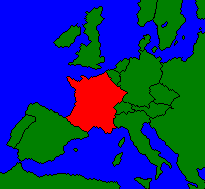

Seventeenth and Eighteenth Century
France
|
| Later Developments | Review Quiz |
Basic PrinciplesThere is no other period in the history of the organ and its music for which we have a body of literature that survives with such complete registration instructions as we do for the Classical French repertoire. Even in the twentieth century, composers - - aware of the wide variety of instruments and dispositions that might be used for their music - - have for the most part been content to give only modest suggestions to the performer. In the period of the French Classical organ, however, no such diversity of instrument design and construction existed. An organ in one place was made like an organ in another. The consistent disposition found on virtually all organs of the period lead to conventions in registration that were respected and followed throughout all of France. To be sure, some differences can be found in both instruments and registration practices from the extremes of the period, but these differences are slight compared to the element of continuity and consistency one finds in the surviving sources. In other words, a French organ from end of the eighteenth century has more features in common with an instrument of the middle of the seventeenth century than it has features which distinguish it from the earlier instrument.During the seventeenth century, the principles of registration that characterize the French Classical organ and its literature were being developed along with the instrument and its music. Composers of the time used registration indications as titles of individual movements, and often they published more explicit directions in the prefaces to their publications. This is one area of registration practice in organ music where we have such precise instructions that we ought to follow them whenever possible. You are urged to pick up a piece of music and follow the composer's instructions in order to learn the principles of registration involved in his music. These instructions are readily available in several modern books, and many newer editions of the music include a composer's registration instructions as well as the music. 125 Many of the indications given both in titles of movements and in prefaces to publications are solo and accompaniment registrations. These include specific lists of stops to be drawn for different effects, to be used in specific pitch registers, or to be used to accompany a given melodic line. For the most part, composer's suggestions indicate logical combinations, with reeds, cornets, and combinations that include mutations being used for solo lines, while flutes and/or principals are drawn on an different manual to accompany them. Within this general practice, most instructions indicate that a reed should not be drawn alone as a solo stop; instead, it should be accompanied by its foundations. That is, the 8' Bourdon and 4' Prestant should be drawn on the same manual with the reed. Contrasting solo registrations can also be drawn on a pair of manuals for performance of duo or trio textures where independent but equally important voices are wanted. In a further refinement of the process of naming movements or pieces by their registrations, some titles also included an indication of the register in which the solo line was played, as in these examples:
In compositions where an ensemble of voices is wanted, rather than a solo line, there are two common registrations used in French Classical practice, used both to indicate the stops that are to be used and as titles of pieces:
The most elaborate compositions in the repertory are the Dialogues, which typically included indications for manual changes, alternation between melodic and ensemble textures, and sometimes even special effects involving the use of the Echo division. When no other indication is present, dialogues are meant to be played using the Grand jeu registration. Pedal stops are rarely used, and they are a part of normal registration in only two instances.
|
| Top of Page | Later Developments | Review Quiz |
Later DevelopmentsThe eighteenth century saw little change in the overall approach of a French organ-builder to his trade. The general pattern of Grand orgue, Positif, Récit, Echo and Pédale that developed a century before was by 1700 found in instruments throughout the realm. In detail, however, the organs of the eighteenth century, some of which remain in an unaltered or restored condition, show some differences when compared to their predecessors. In terms of design and construction of individual stops:
In terms of common use of stops, two new ensemble registrations appeared:
|
| Top of Page | Later Developments | Review Quiz |
© 1999, 2000 James H. Cook